Family : Solanaceae

Text © Prof. Giorgio Venturini

English translation by Mario Beltramini
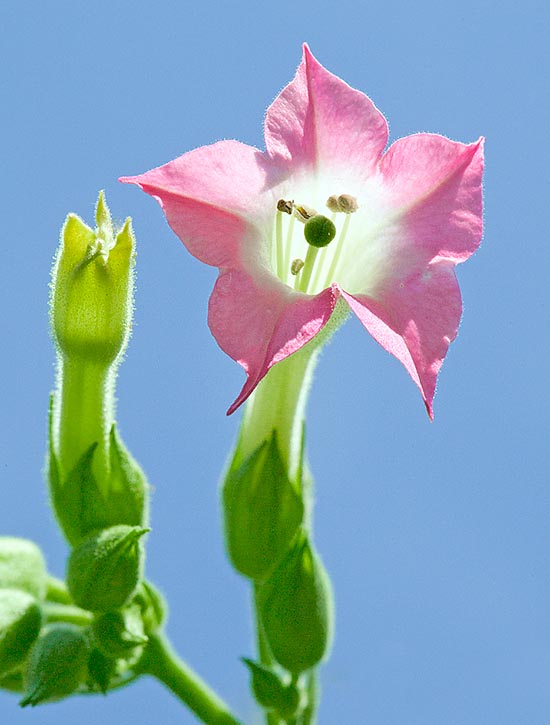
Nicotiana tabacum has tubular flowers merged in corymbiform apical panicles © Giuseppe Mazza
To the genus Nicotiana belong more than sixty species typical mainly of tropical and subtropical locations, mostly of American origin. Few are the species spontaneous to Australia or the South Pacific areas. For the production of the tobacco, besides the Nicotiana tabacum L., 1753 (probably of South American origin), cultivated in all the continents, is often cultivated especially in Asia also the Nicotiana rustica, also of American origin. Other species are cultivated for ornamental purposes.
The name of the genus Nicotiana has been honoured by Linnaeus to Jean Nicot, who, in 1859, made the tobacco known in France. The origin of the term “tabacum” is more uncertain and perhaps comes from the word “tabago” that in the Taino language, spoken by the Arawakan Caribbean populations met by Columbus, indicated, after some sources, the rolls of tobacco leaves used for smoking and after other sources the Y-shaped pipe used to inhale the smoke through the nostrils. It is also possible that the term comes, on the contrary, from the Arabic term “tabbaq”, already known in Spain and in Italy before the discovery of America, which indicated a medicinal plant, maybe the Inula viscosa.
The Nicotiana tabacum is an annual herbaceous plant, of pungent odour, 60 cm to 3 metres tall depending on the variety (Nicotiana rustica is sometimes perennial and is usually 50 to 140 cm tall). The stems are little ramified, usually rounded and, like the other parts of the plant, covered by glandular hairs whose yellowish secretion render the plant viscous to the touch. Oval leaves, alternate, generally sessile or with short petiole, spirally arranged along the stem, in some varieties they may be up to 60-100 cm long and up to 30-40 cm broad, whilst other varieties have much smaller leaves (8-10 cm). In some varieties, the leaves have two auriculae. The flowers are tubular or funnel-shaped, 3-5 cm long, white or cream to pink or carmine coloured, and grow in numerous groups (racemes). The calyx has five triangular lobes of about 1-2 cm. The fruits are ovoid capsules of 1,5-2,5 cm containing numerous brown seeds. The pollination is entomophilous and the main pronubes are hymenopterans and lepidopterans.
Pharmacology and toxicity
The tobacco contains several substances with pharmacological action, the most important being the nicotine. Furthermore, it contains some glycosides, the 2-naphthylamine (a highly carcinogenic substance) and some beta-carbolines, among which the harmala alkaloids. All the parts of the plant, but the seeds, contain nicotine, whose concentration varies depending on the different varieties or species of tobacco, and changes after the characteristics of the soil and the climate and the age of the plant. The largest amount of nicotine (64%) is found in the leaves, in the stem is present the 18%, the 13% in the roots and only the 5% in the flowers.
The nicotine
The substance is produced in the roots and then carried around all the plant, where it performs an important defensive action especially against the phytophagous insects. For this reason, it has been widely used as insecticide (presently are utilized some analogous synthetics). From a pharmacological point of view the nicotine is a powerful stimulant which acts exciting the receptors of nicotinic type for the acetylcholine neurotransmitter. Its action works on the central nervous system and on the parasympathetic system. When the smoke of the tobacco is inhaled into the lungs the nicotine is absorbed by the blood and quickly reaches the brain where, in a few seconds, stimulates in the neurons the release of many neurotransmitters, like, for instance, the acetylcholine, the noradrenaline, the serotonin, the dopamine and the endorphins.
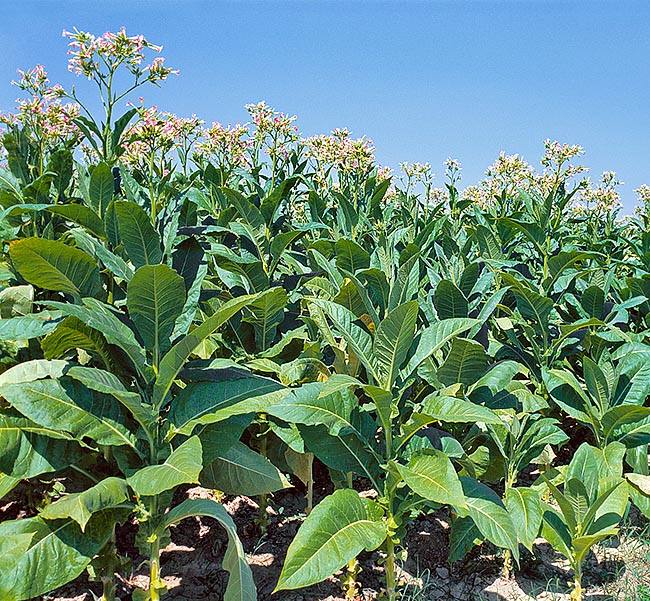
Viscous annual herbaceous species of strong odour, is amply tilled and can be 3 m tall © Giuseppe Mazza
Higher dosages of nicotine may have an action opposite to those cited.
This set of actions on the nervous system activity, with the excessive and prolonged stimulation of the receptors, generates with the time addiction and dependence.
The nicotine is one of the drugs more capable to cause dependency. The use of nicotine inhibits the appetite and may cause a loss of weight; moreover, it increases the cardiac rhythm and the pressure and contributes to the forming of thrombosis and atherosclerosis in the smokers.
Last years studies have shown that the nicotine is also capable to increase the capacity of the cocaine to induce dependency.
In spite of its toxicity, therapies based on nicotine are used for helping to quit smoking as, by administering the drug through ways differing from the cigarettes, the inhalation of the toxic and carcinogenic substances contained in the smoke is avoided.
Beta-carbolines
These substances, contained in the tobacco and other vegetable, are highly psychoactive, thanks especially to the capacity of inhibiting some enzymes, the monoamino oxidases, which have the function of destroying the molecules of neurotransmitter such as the dopamine and the noradrenaline. The result is therefore that of prolonging the stimulation of many neurons. The beta-carbolines are also inhibitors of the GABAA receptor (that stimulated by the barbiturates) and have consequently an excitant and anxiogenic action. These substances are the man components of the hallucinogenic and psychedelic drug Ayahuasca, used by the Amazonian populations of Peru.
The smoke of the tobacco
The smoke of the tobacco, besides containing nicotine and the other cited substances, contains an important series of products of the combustion, among which we recall the tars, the aromatic polycyclic hydrocarbons, the nitrosamines, arsenic, benzene, cadmium, chromium, formaldehyde, 1-3 butadiene and acroleins. All these substances have a toxic, irritant and carcinogenic action.
The pathologies induced by the smoke of the tobacco are numerous and interest, besides the nervous system, manly the heart and the circulatory system, the lungs and the liver. The smoke is therefore an important risk factor for heart attack, stroke, pulmonary emphysema and chronic bronchitis as well as for numerous types of tumour, in particular to the lung, the larynx and pancreas. The smoke is an aggravating factor for many hepatic diseases, including the fibrosis and the hepatocellular carcinoma. These pathologies add to the powerful properties of the nicotine to generate dependency (smoking).
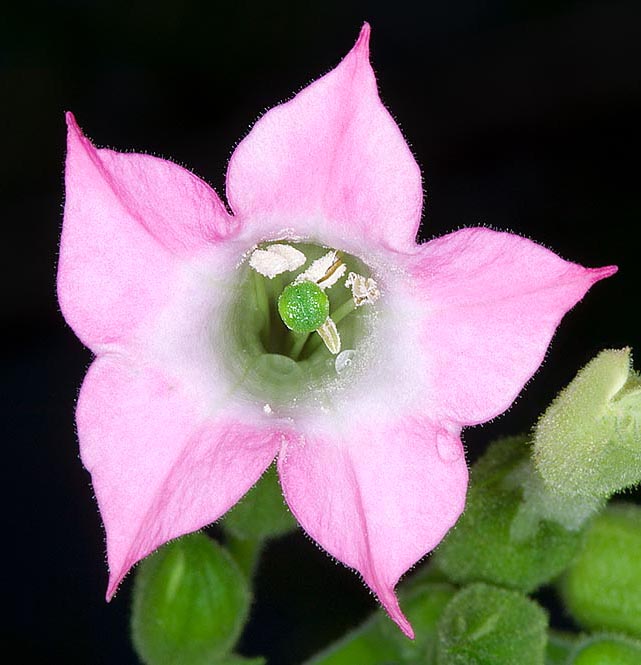
White-yellowish, pink or carmine calyx. Main pronubes are hymenopterans and butterflies © Giuseppe Mazza
A health problem of major importance is that of the passive smoking, that is, the exposition to the smoke of the person who, non-smoker, shares an environment with smokers. The damages of the passive exposition are high and of the same type of those faced by the smoker. Particularly important is that of the children induced during the pregnancy by the smoke of the mother on the foetus. We can remind that the increase of the preterm deliveries, the loss of weight at the birth, lower stature, increase of the infections of the newborn and increased susceptibility to respiratory infections that last even for many years, increase of the behavioural problems and increased rates of childhood tumours.
History
Already during his first voyage of 1492, Christopher Columbus observed that the natives cultivated and utilized the tobacco as medicinal as well as for the pleasant effect of the smoke and reported that the inhalation of the smoke caused at times the loss of knowledge. After the reports of the voyage, the inhabitants of Cuba and of Haiti smoked the leaves shaped like cigars. Also other voyagers of the time confirm these observations but erroneously report for the leaves the name of “tabaco” which, on the contrary, referred to the Y-shaped pipes, with which they inhaled the smoke through the nostrils. The plant was instead called with various names, among which “petum” and “cogioba”, and these names appear also in the first herbaria. It seems that Rodrigo de Jerez, one of the crewmembers of the carrack Santa Maria, Christopher Columbus’ flagship, has been the first European to experiment the smoke (contrary to what passed down through tradition, the Santa Maria was not a caravel like the Niña and the Pinta).
The tobacco reached Span by the 1528, where was cultivated for medicinal purposes. In 1559 Jean Nicot, French ambassador in Portugal, carried one specimen of the plant in France, and used the leaves for treating a migraine of the Queen Catherine de’ Medici and an ulcer to her son, Francis I. For this reason the tobacco was called Nicot’s herb or queen’s herb and in honour to Nicot now we use the names of Nicotiana and of Nicotine. In Europe the tobacco got fame of portentous medicine, gaining the name of “sacred herb” and in a 1571 opus on the medicinal plants its effect are boasted on 36 different sicknesses.
In the same period, the cardinal Prospero di Santacroce, who had been nuncio to the Kingdom of Portugal, introduced the tobacco in Italy, in the Papal States, and began its cultivation and trade. In Rome, the plant was called “Erba di Santacroce” and his family maintained for long time a major role in the trade of the tobacco, so much that in Rome the shops selling it had as sign the cross of the family ensign. It has been said that Sir Walter Raleigh has carried for the first time the tobacco in England, actually, the tobacco was already known, but it was Raleigh who rendered its use popular at the English court (it seems that Raleigh has been the first to carry also the potatoes in England, or at least has introduced their cultivation in Ireland). After the initial enthusiasms the criticisms came, so much that in 1604 the King James I of England denounced the tobacco as harmful for the lungs and the brain, besides being disgusting for the smell. In the same year, however, heavy taxes on its import were enforced, to show the economical interest.
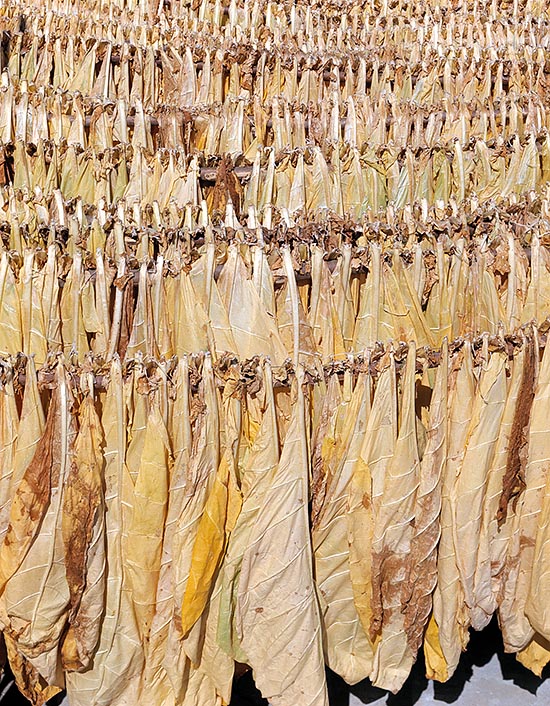
The leaves, here lying in the sun for making tobacco, measure 60-100 cm © Giuseppe Mazza
The cultivation of the tobacco developed in North America starting from 1602, and initially with Nicotiana rustica and after with Nicotiana tabacum, imported from Bermuda, and rapidly became on of the major resources which, along with the cotton, stimulated the development of the southern states and the import of slaves from Africa. It seems that the first really productive cultivation of tobacco in North America had been installed in Virginia by John Rolfe (1585-1622), husband of the famous Native American Pocahontas. During the second half of the ‘800 the use of the tobacco, smoked or chewed got in the rural North America an enormous diffusion, with women and even 8 years old children heavy smokers of pipe, done with the corn cob (Huckleberry Finn, the boy hero of the novel of the same name written by Mark Twain, has always the pipe in its mouth when he manages to escape his intrusive educators). A history of the States of the South written in those years describes the continuous spits of yellowish saliva soiling the floors in spite the spittoons placed everywhere. It is estimated that in the world the cigarette smokers are more than a billion.
The awareness of the serious effects of the tobacco on the health has stimulated in many countries campaigns against smoking and restrictive laws which, in the most developed countries, have led to a remarkable reduction of the consumers. On the contrary, in many developing countries we see an increment of more than the 3% per year. Presently, the biggest consumers are the Balkan countries and those of the former URSS, with on top Serbia, Bulgaria, Greece and Russia, besides some Asian countries.
Parasites of tobacco
Even if the content of toxic substances of the tobacco is so high to discourage most of the phytophagous (the tobacco contains, inter alia, the germacrenes, substances with antimicrobial and insecticide activity), also many insects nourish of the leaves and represent a problem for the cultivations. Examples are the caterpillars of various Lepidopterans of the genus Manduca or Chrysomelids of the genus Epitrix, which, in particular, has caused serious damages by the end of the ‘800.
For various reasons a particular mention deserves the tobacco mosaic virus. This virus, highly infectious, transmits directly by touch (source of infections are the hands of the farmers, without need of vectors, and infects, apart the tobacco, also the tomato, the potato, the sugar beet and many other plants of economical interest. As the name suggests, the pathology manifests with the appearing of yellowish or brown spots on the leaves. The infection damages the chloroplasts and the consequent reduction of the photosynthesis causes a serious deterioration of the plant. The virus is not pathogenic for the man or the animals. This has been the first virus discovered, thanks to studies done between the 1892 and the 1898, which showed for the first time the existence of an infective agent capable to get through the filters of porcelain used for the sterilization of the liquids, and therefore smaller than all the bacteria (it was hence coined the term of “filterable virus”, meaning as “virus” in general every pathogenic agent. After, the term was abbreviated in “virus” tout court). In 1935 they got to crystallize the virus (1946 Nobel Prize), proving its extreme chemical simplicity (it is formed only by a molecule of RNA and by multiple copies of one only protein), and it was demonstrated that merging the RNA molecule and the protein, a functional virus did form again. In the most recent years it has been finally possible to synthesize completely in laboratory the biologically active virus.
The tobacco and the scientific research
Nicotiana tabacum is one of the most studied vegetables, not only in the applied research, seen its great economical interest, but also in the basic research. In fact, this plant is characterized by a rapid reproduction and fast growth and is easy to modify genetically (OGM production for the research). For these reasons, the tobacco has been used for many studies of general interest, including those on the regulation of the multiplication of the cells (cellular cycle), on the plants response to the pathogens, on the synthesis mechanisms of many substances and on the oxidative stress.
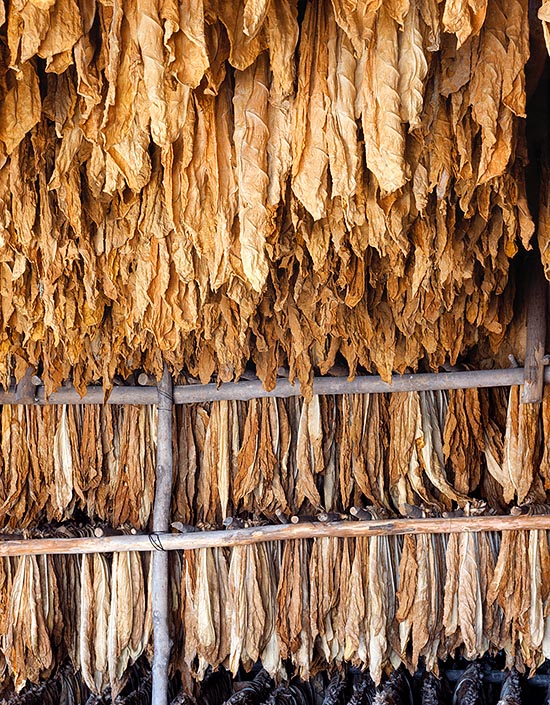
Then are ripened in the shade. Tobacco is a dangerous drug © Giuseppe Mazza
The first explorers of the Americas referred that the natives used the tobacco as narcotic and for treating abscesses, ulcers, burns and many other pathologies such as the headache, the phlegm and the diarrhoea. Amerigo Vespucci reports also the use of the tobacco for preparing a toothpaste (this use is still spread in India where is also commercialized a product). The Incas cultivated the tobacco and used it for medicinal purposes. The tobacco is much used in the traditional medicine of numerous countries, especially in South America.
The leaves, fresh, dried or macerated in various ways, are utilized for inducing narcosis or vomit, for treating infected wounds, dermatitis, cutaneous mycoses, for preventing baldness, for treating the dysmenorrhea or for inducing the time of delivery, as anthelmintic, for the bite of the snakes, as anti-rheumatic, as repellent for insects or against the lice. The European herbal practice has amply utilized the tobacco with the most different indications, for instance as antispastic, diuretic, antiemetic, expectorant, sedative, antinauseant and for treating the seasickness. Applied externally, it was utilized as anti-rheumatic, for cutaneous diseases and against the sting of the scorpions or of insects. Smoke enemata have been utilized in the past for the abdominal pains and for the drowning.
Magical and ritual uses
The Mayas considered the tobacco as a sacred plant and used it as drug for inducing trance and visions for contacting the divinities. They used also infusions to be administered as enemata for getting the trance. Some Mexican contemporary populations use the leaves for preparing infusions with ritual purposes. We have not to forget that these populations, as well as the Amazonian Indio, used and still use the species Nicotiana rustica which has nicotine content almost ten times more than Nicotiana tabacum and contains very high quantities of beta-carbolines and has therefore very powerful narcotic and hallucinogenic properties. The Nicotiana rustica is still now very used for inducing mystic trances by the shamans of many native South American populations. The leaves are used for preparing infusions to drink or to use as enemata, chewed, smoked or producing smoke to introduce via enema. The tobacco stands also in the composition of the Ayahuasca (ayawasca in Quechua language), Amazonian and Andin sacred hallucinogenic drink, based mainly of Banisteriopsis caapi, a Malpighiacea rich of beta-carbolinic alkaloids. A particular utilization of the Amerindian populations of Canada was that of preparing eyewash said to cause the vision of the spirits.
As we can see in all the western movies, the “Redskins” of North America smoked for ritual and propitiatory purposes the “peace pipe” or “calumet”. This contained a herb mix, called by some native populations “Kinnikinnick” usually composed by Nicotiana rustica and by other plants with psychotropic action, such as the stramonium. Many explorers who have proved the Kinnikinnick say having appreciated it very much as ersatz of the tobacco. It is to be noted that the term “calumet” is not a word of the Amerindian languages, but comes from the French term chalumeau (from the Greek calamos, reed), which indicates a musical instrument similar to the clarion used in the XVI and XVII centuries).
Synonyms for the genus Nicotiana : Amphipleis Raf.; Blenocoes Raf.; Dittostigma Phil.; Eucapnia Raf.; Langsdorfia Raf.; Lehmannia Spreng.; Perieteris Raf.; Polydiclis (G.Don) Miers; Sairanthus G.Don Siphaulax Raf.; Tabacum Gilib.; Tabacus Moench Waddingtonia Phil.
Synonyms of Nicotiana tabacum : Nicotiana chinensis Fish. Ex Lehm.; Nicotiana mexicana Schltdl.: Nicotiana mexicana var. rubriflora Dunal; Nicotiana pilosa Dunal; Nicotiana tabaca St.-Lag.
→ To appreciate the biodiversity within the SOLANACEAE family please click here.
